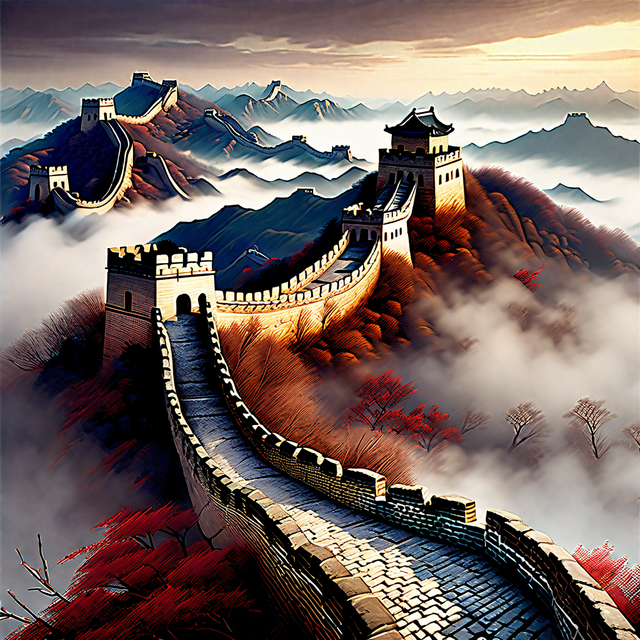
说到长城,我们不禁要感叹到古人的智慧。长城是中国的一张名片,是中华民族的瑰宝,也是世界文化遗产。是中国古代的一项壮丽工程,其起源可以追溯到战国时期(公元前475年-公元前221年)。当时,为了防御北方游牧民族的侵扰,赵国、秦国、燕国等国家开始修建城墙来保护自己。秦统一六国后,始皇帝下令将各国的城墙连接起来,形成了长城的雏形。长城的总长度超过2.1万公里,穿越山川河流,构成了一道坚不可摧的防线。
长城的地理位置十分特殊,沿线分布着许多险峻的山岭和河流,为游客带来了壮美的自然风光。长城经过不同的省市,如北京、天津、河北、山西、内蒙古等,每个省市都有自己独特的文化和风情。
长城的文化价值不言而喻,它是中国古代文化的重要组成部分。在长城沿线,游客可以欣赏到不同朝代的建筑风格和石刻艺术,领略中华民族的智慧和勇气。
当然,在不同时期,长城的形态和修建方式也有所不同。例如,明朝时期(1368年-1644年),长城得到了大规模的修缮和扩建,形成了现今我们所见到的长城的基本形态。其中,山海关、居庸关、嘉峪关等重要关隘都是明朝修建的。
长城有着悠久的历史和文化底,对中国历史的影响深远,是中华民族的骄傲和象征。首先,长城的修建保卫了中原地区的稳定和安全,使得农耕文明得以继续发展。其次,长城的修建也促进了不同地区之间的交流和融合,推动了文化和经济的发展。此外,长城也成为了中国历史上的重要景观之一,吸引着无数文人墨客前来游览和吟咏。到长城不仅可以欣赏到壮美的自然风光和古老的文化遗产,还可以深入了解中华民族的历史和文化底蕴。
When it comes to the Great Wall, we cannot help but marvel at the wisdom of the ancients. The Great Wall is a business card of China, a treasure of the Chinese nation, and a world cultural heritage. It is a magnificent project in ancient China, dating back to the Warring States period (475-221 BC). At that time, in order to defend against the invasion of nomadic tribes in the north, countries such as Zhao, Qin, and Yan began to build city walls to protect themselves. After Qin unified the six states, the First Emperor ordered the connection of the city walls of various countries, forming the prototype of the Great Wall. The total length of the Great Wall exceeds 21000 kilometers, crossing mountains, rivers, and forming an unbreakable defense line.
The geographical location of the Great Wall is very unique, with many steep mountains and rivers distributed along the route, bringing magnificent natural scenery to tourists. The Great Wall passes through different provinces and cities, such as Beijing, Tianjin, Hebei, Shanxi, Inner Mongolia, etc. Each province and city has its own unique culture and customs.
The cultural value of the Great Wall is self-evident, as it is an important component of ancient Chinese culture. Along the Great Wall, tourists can appreciate the architectural styles and stone carving art of different dynasties, and appreciate the wisdom and courage of the Chinese nation.
Of course, the form and construction method of the Great Wall also vary in different periods. For example, during the Ming Dynasty (1368-1644), the Great Wall underwent large-scale repairs and expansion, forming the basic form of the Great Wall that we see today. Among them, important passes such as Shanhai Pass, Juyong Pass, and Jiayu Pass were all built during the Ming Dynasty.
The Great Wall has a long history and cultural background, and has a profound impact on Chinese history. It is the pride and symbol of the Chinese nation. Firstly, the construction of the Great Wall protected the stability and security of the Central Plains region, enabling the continued development of agricultural civilization. Secondly, the construction of the Great Wall also promoted communication and integration between different regions, promoting cultural and economic development. In addition, the Great Wall has also become one of the important landscapes in Chinese history, attracting countless literati and poets to visit and sing. Visiting the Great Wall not only allows one to appreciate the magnificent natural scenery and ancient cultural heritage, but also provides a deeper understanding of the history and cultural heritage of the Chinese nation.